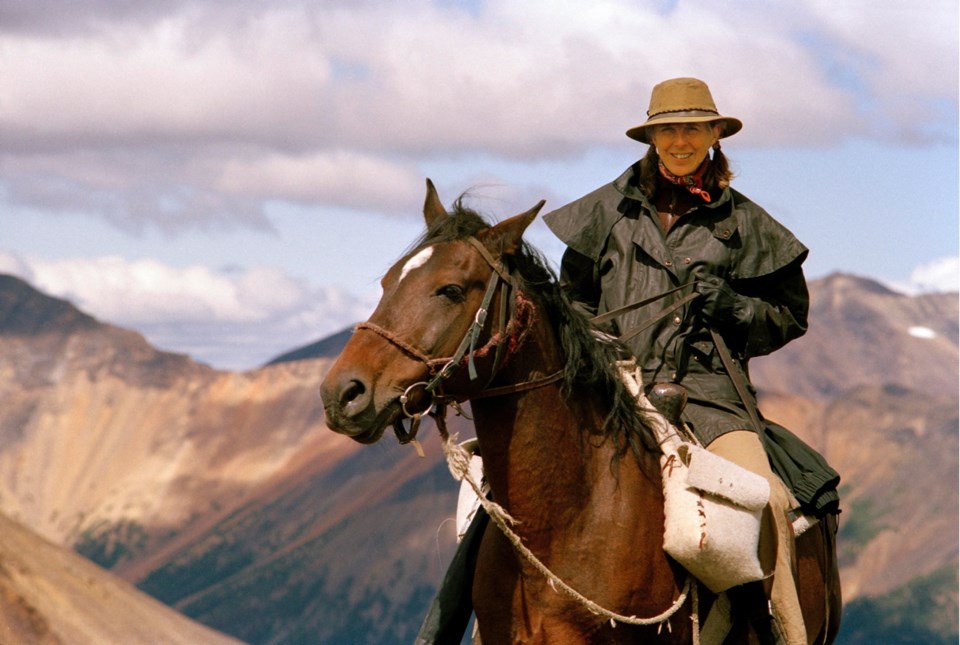Being a big-city boy at heart, I recoiled in horror when a massive moose was stalked, shot, skinned and butchered by two indigenous hunters in an astonishing scene from Koneline: our land beautiful.
I felt just as bad for several horses being smacked with large sticks to encourage them to swim across the wide Stikine River, until their adoring owner, outfitter-guide Heidi Gutfrucht, explained why.
These are two memorable moments in Nettie Wild’s beautiful celebration of northwestern B.C. and its characters who co-exist despite differing agendas.
The Vancouver filmmaker behind FIX: The Story of an Addicted City (2002) and A Place Called Chiapas (1998) will appear during screenings of the film that opens today at Cinecenta.
Shot over a year in the mountains of northwestern B.C., one of Koneline’s chief strengths is how Wild and her crew bring such jolting northern images into perspective and challenge viewers to check their assumptions at the door.
“When I want meat, I go to Safeway and buy something wrapped in cellophane,” said Wild, who admits she, too, was uncomfortable watching that moose being casually disembowelled.
The good news for squeamish filmgoers is that the artfully photographed moose metamorphosis is the most grisly sequence in Wild’s predominantly uplifting and lyrical film.
Wild said she thought it was necessary to “cut that scene long,” and not just because it took five hours to get those shots in Tahltan First Nation’s traditional territory.
Capturing the playful banter between Tahltan hunter Orville Brown and his nephew during their grunt work was essential, she said.
“Even though we’re an urban team, we wanted to move from the moose being this live, beautiful sentient creature to this huge chunk of meat,” Wild said.
“Within that, there is a weird beauty, and this extraordinary relationship between two characters Hollywood couldn’t even create.”
Wild’s film intercuts footage capturing the lifestyles of the local indigenous community with those of wilderness hunting guides on horseback, white trophy hunters using bows and arrows, transmission linesmen, diamond drillers, and miners, both whites and natives, who work at Imperial Metals’ Red Chris gold-and-copper mine, as much a part of the landscape as the pristine wilderness nearby.
Despite the mine’s economic benefits, memories of Imperial’s Mount Polley Mine tailings pond spill in 2014 remain, stirring conflict in a community where locals band together to save stranded salmon.
While Koneline features tribal elders who erect a blockade to protect their ancestral land, this is no polemical blockade movie. It’s a meditative, surprisingly balanced portrait of disparate characters, from natives to prospectors, who share a deep affection for the land, the commonality that Wild said inspired her cinematic approach.
“It’s my attempt to cut through the din of rhetoric and ask people to share a visceral experience of the North, rather than tell people what to think,” she said.
This includes images of mineral development in the Golden Triangle that are as striking as widescreen shots of B.C.’s natural beauty. Glorious wilderness vistas are complemented by images such as a riveting Northwest Transmission Line construction sequence. The sci-fi-like spectacle involves a huge helicopter delicately lowering a 16,000-pound transmission tower to windswept linemen wrestling it into place.
“There is an elegance of engineering to it. The dexterity and the brawn of the men and the beauty of the landscape and the environmental devastation is all there,” she said.
Interestingly, audience reaction has differed regionally, Wild said, using the graphic moose-hunting sequence as an example.
“Up north, it’s the favourite scene. People find a lot of humour and irony,” Wild said.
While the scene has prompted laughter in northern theatres, filmgoers have been “deadly quiet” in southern theatres, with some covering their eyes, she said.
“I don’t think I’ve ever made a movie before where if there are 350 people in the audience, there are 350 different movies playing in everyone’s heads.”
While this urban outsider initially met resistance from the dubious mining industry, and from more militant Tahltan blockaders who denied her access, a curious twist of fate helped open doors.
It began when Hy-Tech Drilling founder Harvey Tremblay let Wild film his diamond drillers at Pretium Resources’ Bruce Jack mine, motivated by a desire to have the mining industry engage in a larger conversation.
Tremblay learned that Wild had inherited her love of the bush from her grandfather, a doctor whose passion for fishing was matched by his belief “that something that glitters in earth would grow into something bigger.”
Her grandfather also bought a mine — “just seven holes in the ground in the Kootenays” — that she inherited. Although it didn’t amount to much, she said it helped her appreciate the whole narrative.
“I had that in my hip pocket,” Wild said. “A lot of people in the mining industry were surprised by how it turned out.”



